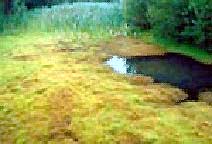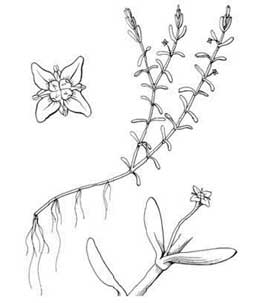Crassula helmsii (T. Kirk) Cockayne, commonly known asAustralian Swamp Stonecrop or New Zealand Pigmyweed is a succulentperennial herb that has invaded a wide range of wetland habitats suchas ponds, lakes, gravel pits and other static water-bodies. It is nowpresent at well over 600 sites in the British Isles. This plant is amember of the Crassulaceae but differs from most of itsrelatives in needing wet or damp conditions to grow. It has theability to adapt its morphology to various conditions ranging frommoist terrestrial situations to fully submerged and tends to growextremely vigorously, and out-compete many native species.

Living material of Crassula helmsii was originally soldunder the name Tillaea recurva by Perrys Hardy Plant Farm,Enfield, Middlesex from 1927. It was sold as a submerged’oxygenating’ aquatic. The original specimen is thought to have beencollected in Australia during the early 1920s. It was only availablefrom this one supplier until the 1970s. Thereafter it becameavailable from many aquatic suppliers. The first collection in anaturalised situation was made in Greenstead, Essex in 1956, but by1961 Crassula helmsii had been designated as an establishedalien plant in Britain.
After the initial introduction into a new area C. helmsiihas many modes of dispersal including, transfer from pond to pond byanglers, wildfowl, ponies (e.g. in the New Forest), children ponddipping and even botanists survey equipment and their boots. Thesemodes of distribution are possible because of the regenerationpotential of even the smallest stem fragment. A node with 5mm of stemhas the ability to produce at least one viable plant and, onceestablished, it soon becomes dominant. It is also likely that therecent resurgence in recreational water gardening has increased theopportunities for C. helmsii to extend its range, throughgarden centre sales, by ‘friendly’ inter-pond transfer or by releaseinto natural water bodies as a result of reluctance to destroy pondthinnings.
In Britain C. helmsii exhibits three growth forms. Whengrowing fully submerged in deep water (>0.5m), it is well rootedat the base, reaching a maximum length of 1.3 m. Plants growing indeep water have particularly thin, barely succulent leaves which aresparsely distributed along the upper stems. These leaves are 0.3-0.4mm thick and more than 10 mm long. Inter-nodal lengths are often verylong (20-25 mm) in the lower part of the plant but are much shorter(5-12mm) towards the apical end.

In shallow water (<0.5m), growth becomes dense with much morebranching. The stems become emergent during summer, either by thegrowth of the plant, or a decrease in water level or both. In thesefluctuating conditions the plant forms a very dense mat of sprawlingstems from which many side shoots with succulent leaves arise. Thisproduces a turf which is very effective in inhibiting the growth ofother species. Culture trials in static water suggest that the changefrom production of the submerged to emergent leaves and vice versa israpid. In addition a shallow-water growth form can occasionally beseen extending into deeper water where, although rooted along thebank, its sprawling stems grow out across the surface to form ananchored floating mass.
In seasonal ponds and pond margins C. helmsii is leafierand more compact than shallow water forms. Branching is more frequentas inter-nodal distance decreases, allowing the plant to form awell-anchored turf. Growth on damp mud at the margins of ponds andlakes is restricted to dense mats, which is considered more typicalof its growth in its native range.
Within its native range C. helmsii is a marginal plant inmany river systems. However, within the British Isles, the plant doesnot seem to have made the transition from static or slow flowingsystems to more demanding habitats such as river margins. Studieshave shown that biomass production in artificial systems is greaterthan other species including Elodea canadensis, highlightingthe potential for this plant to colonise rivers systems.










